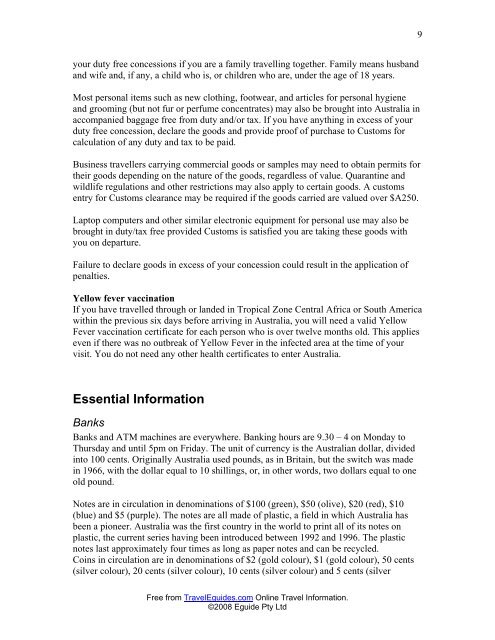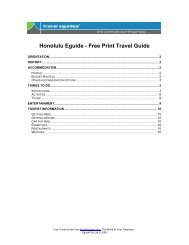Australia Eguide - Travel Guides
Australia Eguide - Travel Guides
Australia Eguide - Travel Guides
Create successful ePaper yourself
Turn your PDF publications into a flip-book with our unique Google optimized e-Paper software.
9<br />
your duty free concessions if you are a family travelling together. Family means husband<br />
and wife and, if any, a child who is, or children who are, under the age of 18 years.<br />
Most personal items such as new clothing, footwear, and articles for personal hygiene<br />
and grooming (but not fur or perfume concentrates) may also be brought into <strong>Australia</strong> in<br />
accompanied baggage free from duty and/or tax. If you have anything in excess of your<br />
duty free concession, declare the goods and provide proof of purchase to Customs for<br />
calculation of any duty and tax to be paid.<br />
Business travellers carrying commercial goods or samples may need to obtain permits for<br />
their goods depending on the nature of the goods, regardless of value. Quarantine and<br />
wildlife regulations and other restrictions may also apply to certain goods. A customs<br />
entry for Customs clearance may be required if the goods carried are valued over $A250.<br />
Laptop computers and other similar electronic equipment for personal use may also be<br />
brought in duty/tax free provided Customs is satisfied you are taking these goods with<br />
you on departure.<br />
Failure to declare goods in excess of your concession could result in the application of<br />
penalties.<br />
Yellow fever vaccination<br />
If you have travelled through or landed in Tropical Zone Central Africa or South America<br />
within the previous six days before arriving in <strong>Australia</strong>, you will need a valid Yellow<br />
Fever vaccination certificate for each person who is over twelve months old. This applies<br />
even if there was no outbreak of Yellow Fever in the infected area at the time of your<br />
visit. You do not need any other health certificates to enter <strong>Australia</strong>.<br />
Essential Information<br />
Banks<br />
Banks and ATM machines are everywhere. Banking hours are 9.30 – 4 on Monday to<br />
Thursday and until 5pm on Friday. The unit of currency is the <strong>Australia</strong>n dollar, divided<br />
into 100 cents. Originally <strong>Australia</strong> used pounds, as in Britain, but the switch was made<br />
in 1966, with the dollar equal to 10 shillings, or, in other words, two dollars equal to one<br />
old pound.<br />
Notes are in circulation in denominations of $100 (green), $50 (olive), $20 (red), $10<br />
(blue) and $5 (purple). The notes are all made of plastic, a field in which <strong>Australia</strong> has<br />
been a pioneer. <strong>Australia</strong> was the first country in the world to print all of its notes on<br />
plastic, the current series having been introduced between 1992 and 1996. The plastic<br />
notes last approximately four times as long as paper notes and can be recycled.<br />
Coins in circulation are in denominations of $2 (gold colour), $1 (gold colour), 50 cents<br />
(silver colour), 20 cents (silver colour), 10 cents (silver colour) and 5 cents (silver<br />
Free from <strong>Travel</strong><strong>Eguide</strong>s.com Online <strong>Travel</strong> Information.<br />
©2008 <strong>Eguide</strong> Pty Ltd




